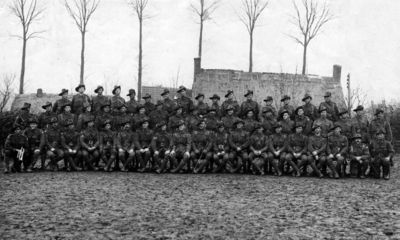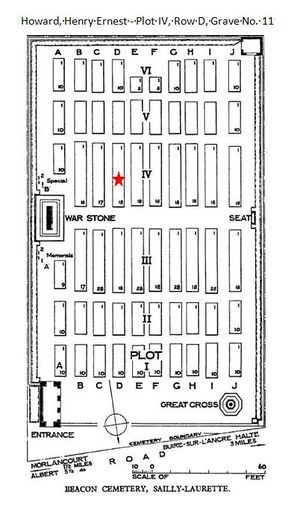Henry Ernest Howard
From Our Contribution
 | |
 Henry back row 2nd from left AWM photo E01501 | |
| Personal Information | |
|---|---|
| Date of Birth | c1892 |
| Place of Birth | Blakeville, Victoria |
| Death | 30 Mar 1918 |
| Place of Death | Sailly-le-Sec, France |
| Age at Enlistment | 23 years, 8 months |
| Description |
5' 10¾" (1.80m) tall ; 156 lbs 70.76 kg ; fair complexion ; brown eyes ; brown hair |
| Occupation | Sleeper hewer |
| Religion | Church of England |
| Address | Railway avenue, Kelmscott, Western Australia |
| Next of Kin | Father , Mr David Charles Howard |
| Military Information | |
| Reg Number | 443 |
| Date of Enlistment | 6 Jan 1916 |
| Rank | Corporal |
| Unit/Formation | 44th Battalion, B Company / 11th Brigade, 3rd Division |
| Date of Embarkation | 6 Jun 1916 ‒ 21 Jul 1916 |
| Ship Embarked On | HMAT A29 Suevic |
| Fate | Killed in Action 30 Mar 1918 at Sailly-le-Sec during 1st Battle for Mourlancourt |
| Monument |
Kelmscott War Memorial (North panel) Kelmscott Congregational Church Honour Board Australian War Memorial |
| Medals |
British War Medal Victory Medal |
Contents
Pre War
War Service
Entered camp on 17 Jan 1916 and after a little over a week with the 44th Depot Company, he was posted to "B" Company of the newly formed 44th Battalion on 28 Jan 1916 at the Claremont camp. After more than five months training they were ready to travel to England.
On the voyage to England, at Cape Town on 25 Jun 1916, Henry failed to re-embark in time for the voyage to England. The result was that he faced military justice on his arrival at Larkhill, losing 28 days pay (£8/8/-), 14 day's Field Punishment No.2 and a £5 fine. (See notes). Before serving his full term of field punishment, he was hospitalised in the 1st Australian Dermatological Hospital at Bulford on 10 Aug 1916 for 52 days with syphilis, being discharged on 30 Sep 1916.
Rejoining his unit on 2 Oct 1916, he was AWOL from a parade on 21 Nov 1916 before the battalion proceeded to France from Southampton on 25 Nov 1916. From 3 - 9 Feb 1917 he was absent from the battalion while receiving treatment for scabies, but then settled down and was promoted first to Lance Corporal on 7 Oct 1917 and then Corporal on 1 Mar 1918 before his death in the battle for Morlancourt.
Henry was a member of "B" Company which was at that time attached to the 42nd Battalion, serving as piquet's, dug in on a hillside above Sailly Laurette in front of the main Australian defensive position manned by the 42nd and 43rd Battalions. This battle was one of those associated with Australian units who had been transferred from the Ypres area to the Somme to halt the enemy's push towards Amiens. The out posted men did stop a major enemy attack. Most of the casualties suffered on 30 Mar 1918 by the 44th Battalion were members of "B" Company. The battalion's losses for the day being 8 KIA, 22 WIA and 1 MIA. However, they had halted the enemy's rapid advance, and given time for other units to move into place.
Notes
Field punishment could be awarded by a court martial or a commanding officer for any offence committed on active service. There were two categories of field punishment. Field punishment No. 2 consisted of heavy labouring duties, and several hours a day shackled . All offenders awarded field punishment would march with their unit, carry their arms and accoutrements, perform all their military duties as well as extra fatigue duties, and be treated as defaulters.
